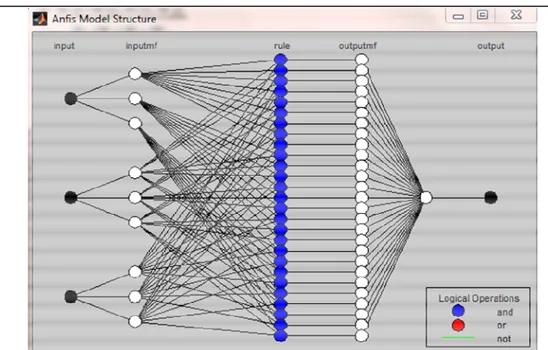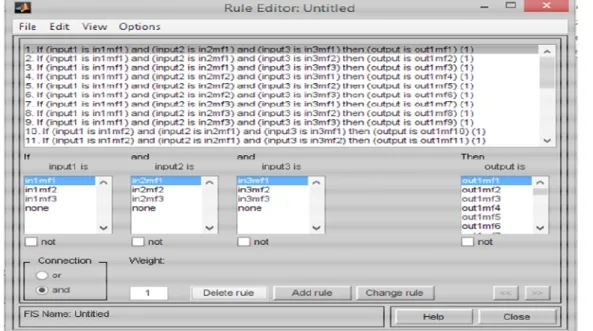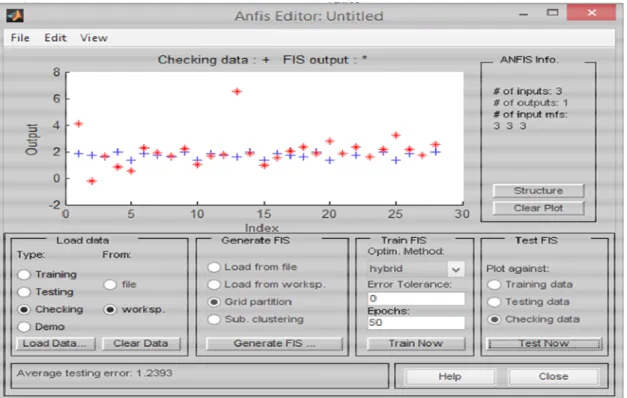ADAPTIVE NEURO-FUZZY INFERENCE SYSTEM FOR
OKRA YIELD PREDICTION
O. A. OJESANMI, A. D. ADEKOYA AND A. A. AWOSEYI
Department of Computer Science, Federal University of Agriculture, Abeokuta, Nigeria
*Corresponding author: dejioje@yahoo.com Tel: +2348056052007
may be done by using three major objective methods: biometrical characteristics, weather variables and agricultural inputs (Agrawal et
al. 2011). These approaches can be used
indi-vidually or in combination to give a compo-site model.
The need for quantitative statistical crop yield forecast outlooks has been felt for quite some time. A beginning towards its realiza-tion has been made by undertaking a study of past crop yield in relation to meteorologi-cal parameters, principally rainfall and tem-perature. Several studies have been conduct-ed to forecast crop yield using weather pa-rameters (Pankaj, 2011; Stathakisa et al.,
2006;). Such forecast studies, based on
statis-tical models need to be reiterative and for
ABSTRACT
This paper, adaptive neuro-fuzzy inference system for okra yield prediction, describes the use of neuro -fuzzy inference system in the prediction of okra yield using environmental parameters such as mini-mum temperature, relative humidity, evaporation, sunshine hours, rainfall and maximini-mum temperature as input into the neuro-fuzzy inference system, and yield as output. The agro meteorological data used were obtained from the department of agro meteorological and water management, Federal University of Agriculture, Abeokuta and the yield data were obtained from the Department of Horticulture, Federal University of Agriculture, Abeokuta. MATLAB was used for the analysis of the data. From the results, the maximum predicted yield showed that at minimum temperature of 24.4 oC, relative humidity of 78.3% and evaporation of 5.5mm, the yield predicted is 1.67 tonnes/hectare.
Keywords: Crop yield, Prediction, agro meteorological data, cultivation, harvest.
INTRODUCTION
In Nigeria, it is possible to cultivate diverse crops due to varied climatic conditions. Among these crops, okra (Abelmoschus
escu-lentus) is an important vegetable crop which
provides food for the nation’s fast-increasing population and has export poten-tial for foreign exchange earnings. One of the severe threats to agricultural productivi-ty in Nigeria and Africa at large is climate change (Odjugo, 2010). Crop failure on account of climate changes have a severe repercussion not only on the country’s economy but also on the availability of food.
Crop prediction is the art of estimating crop yields and production before the harvest,
Journal of Natural Science, Engineering
and Technology
ISSN:
Print - 2277 - 0593 Online - 2315 - 7461
O. A. OJESANMI, A. D. ADEKOYA AND A. A. AWOSEYI tions and weather shifts at different
loca-tions and areas. There is a need to develop area specific forecasting models based on time series data to help the policy makers for taking effective decisions to counter ad-verse climatic situations in food production. Nowadays, there are a lot of yield prediction models, which have been generally classified into two groups: statistical models, and crop simulation models (e.g. CERES). Nonethe-less, the recent applications of Artificial In-telligence (AI) techniques, such as Artificial Neural Networks (ANNs), Fuzzy Systems and Genetic Algorithm have shown to be more effective in solving these problem. The application of AI-techniques can make models easier and more accurate for com-plex natural systems with many inputs (Smith et al., 2009; Kefaya et al., 2012; Kos-ko, 1992).
Adaptive Neuro Fuzzy Inference System (ANFIS) which is an integration of neural networks' features and fuzzy logic has the potential to capture the benefits of both fields in a single framework. The ANFIS utilizes linguistic information from the fuzzy logic as well as the learning capabili-ties of an artificial neural network(Czogala and Leski, 2000; Ehret et al., 2011; Snehal and Sandeep, 2014). An ANFIS is a kind of artificial neural network that is based on Takagi–Sugeno fuzzy inference system. It is considered generally as a multilayer feed forward adaptive network, where each node performs a particular function with its cor-responding input parameter set.
ANFIS ARCHITECTURE
For simplicity, it is assumed that the fuzzy inference system under consideration has
two inputs and one output. The rule base contains the fuzzy if-then rules of Takagi and Sugeno’s type (Takagi and Sugeno, 1983) as follows:
If x is A and y is B then z is f(x,y)
where A and B are the fuzzy sets in the ante-cedents and z = f(x, y) is a crisp function in the consequent. Usually f(x, y) is a polynomi-al for the input variables x and y. But it can also be any other function that can approxi-mately describe the output of the system within the fuzzy region as specified by the antecedent. When f(x,y) is a constant, a zero order Sugeno fuzzy model is formed which may be considered to be a special case of Mamdani fuzzy inference system where each rule consequent is specified by a fuzzy sin-gleton. If f(x,y) is taken to be a first order polynomial a first order Sugeno fuzzy model is formed. For a first order two rule Sugeno fuzzy inference system, the two rules may be stated as:
Rule 1: If x is A1 and y is B1 then f1 = p1x +
q1y + r1
Rule 2: If x is A2 and y is B2 then f2 = p2x +
q2y + r2
Here type-3 fuzzy inference system pro-posed by Takagi and Sugeno (1983) is used. In this inference system the output of each rule is a linear combination of the input vari-ables added by a constant term. The final output is the weighted average of each rule’s output. The corresponding equivalent AN-FIS structure is shown in Fig. 1. The individ-ual layers of this ANFIS structure are de-scribed below:
Layer 1 (Fuzzification layer): every node I in the layer 1 is an adaptive node. The outputs of layer 1 are the fuzzy membership grade of the inputs, which is given by:
(1)
where, x is the input to node i, Ai is the linguistic variable associated with this node
func-tion and μAi is the membership function of Ai. Usually μAi(x) is chosen as
( 2 )
Or(3)
Layer 2 (Rule layer): Output is the product of all the incoming signals to it and can be represented as,
(4) Layer 3 (Normalization layer): Every node in this layer is fixed. Each ith node calculates
the ratio of the ith rule’s firing strength to the sum of firing strengths of all the rules. The
O. A. OJESANMI, A. D. ADEKOYA AND A. A. AWOSEYI
STUDY AREA
The purpose of this study is to develop forecasting model for predicting the yield of okra at the Federal University of Agricul-ture, Abeokuta, Ogun State, Nigeria. Yield data of okra for ten years (2004-2014) was collected from the Department of Horticul-ture, Federal University of AgriculHorticul-ture, Ab-eokuta. Monthly agro meteorological data of ten years (2004-2014) was also collected from the Department of Agro-Meteorological and Water Management, Federal University of Agriculture, Abeoku-ta. Six weather parameters considered are; minimum temperature, maximum tempera-ture, relative humidity, rainfall, sunshine hours and evaporation.
MATERIALS AND METHOD
The total data is divided into two, namely: training and checking data with the weather parameters serving as the inputs and the yield as the output.
A test to determine the optimal weather pa-rameter combination that influences high yield was carried out using the function ‘exhsrch’ in MATLAB and the single param-eter that has the most influence on the yield is ‘relative humidity’. The two input combi-nation that is most influential on the yield are relative humidity and evaporation; and the three input combination that influences the yield most are minimum temperature, relative humidity and evaporation.
Combinations of minimum temperature and relative humidity were considered as the in-puts to the model, and yield of the current year was considered as the output. Input space partitioning for model structure identi-fication was done by grid partition. Hybrid learning algorithm was used to train the models for runoff prediction. The proposed ANFIS architecture is shown in Figure 2.
(5)
Layer 4 (Defuzzification layer): The output of each node in this layer is simply the prod-uct of the normalized firing strength and a first order polynomial.
(6)
where wi is the output of layer 3 and {pi, qi, ri} is the consequent parameter set.
Layer 5 (Summation neuron): Summation of all incoming signal is computed, i.e.
RESULTS AND DISCUSSION
The training and checking data were now limited to have three inputs: minimum tem-perature, relative humidity and evaporation, and one output, yield. Both data were
load-ed into the ANFIS system and appears on the GUI plot as shown in figure 3. The train-ing data appears as circles superimposed with the checking data, appearing as pluses. Figure 2: Proposed ANFIS Structure
O. A. OJESANMI, A. D. ADEKOYA AND A. A. AWOSEYI Only three input variables were successively
used for the prediction as the ANFIS toolbox automatically generates the rules after running the m file. The fuzzy infer-ence system is generated automatically.
Among triangular, bell shaped, trapezoidal and gaussian membership function, the gen-eralized bell membership function was found most suitable for this study (Figure 4).
Figure 4: Snapshot of ANFIS editor showing rules A total of 27 rules were generated in the
anfisedit guide. The rules are the guidelines of the prediction format used by the editor. Input 1 is the first input variable which is
minimum temperature, input 2 is the second input variable which is relative humidity while input 3 is the third input variable which is evaporation, as shown in Figure 5.
Three (3) bells and constant membership functions were used for 50 epochs. The system was trained using the hybrid param-eter optimization method and was tested
against the trained fuzzy inference system. The output of the trained Fuzzy Inference System (FIS) against the checking data is shown in figure 6.
Figure 6: GUI plot of FIS against checking data
As shown in figure 6, the checking data (+) represents the actual yield while the fuzzy inference system output (*) is interpreted as the predicted yield. It can be deduced from the checking data and in figure 6 that at minimum temperature of 24.4oC, relative
humidity of 78.3% and evaporation of 5.5mm, the predicted yield was equal to actual yield.
CONCLUSION
The paper explored the dynamics of Adap-tive Neuro-Fuzzy Inference System in
The combination of the input variables that influence the prediction model was also de-rived. From the results, the input variables that influenced the yield of okra the most are: minimum temperature, relative humidity and evaporation which were the variables used in training the ANFIS. Hence, ANFIS is an efficient model for the prediction of okra yield.
REFERENCES
Agrawal R., Jain, R.C., Metha, S.C., 2011, “Yield forecast based on weather variables and
agri-O. A. OJESANMI, A. D. ADEKOYA AND A. A. AWOSEYI Czogala E., Leski J. 2000. “Neuro-Fuzzy
Intelligent Systems, Studies in Fuzziness and Soft Computing”, Springer, Verlag, Germany.
Ehret D.L., Bernard D. Hill, David, A., Raworth, B. E. 2011. Neural Network Modelling Of Greenhouse Tomato Yield, Growth And Water Use From Automated Crop Monitoring Data. Computers and
Elec-tronics in Agriculture 79: 82–89.
Food and Agriculture Organization (FAO) of the United Nations, 2013. The State of Food And Agriculture. http:// www.fao.org/docrep/018/i3300e/
i3300e00.htm, accessed on 15-07-2015. Jang, J.S.R. 1993, “ANFIS: Adaptive-Network Based Fuzzy Inference System”,
IEEE Trans. Systems, Man, Cybernetics. 23
(5/6):665-685.
Kefaya, Q., Evor, H., Daciana I. 2012. Adaptive Neuro-fuzzy Modelling for Crop Yield prediction. School of Engineering, the University of Warwick United Kingdom. ISBN: 978-960-474-273-4.
Kosko, B., 1992. “Neural Networks and
Fuzzy Systems: A Dynamical System Approach to Machine Intelligence”. Prentice Hall,
Eng-lewood Cliffs, New Jersey.
Odjugo, P. A. O., 2010. “General Overview of Climate Change Impacts in Nigeria”.
Jour-nal Hum Ecol, 29(1): 47-55.
Pankaj, K., 2011. Crop Yield Forecasting by Adaptive Neuro Fuzzy Inference System. VCSG College of Horticulture, GBPUA&T, Pantnagar, Uttarakhand.
Smith, B.A. et al., 2009. Artificial Neural Networks for Automated Year round Tem-perature Prediction. Computers and Electronics
in Agriculture 68: 52–6.
Snehal S. D., Sandeep, R. V. 2014. Agri-cultural Crop Yield Prediction Using Artifi-cial Neural Network Approach. International
Journal of Innovative Research In Electrical, Elec-tronics, Instrumentation And Control Engineering
2 (1):.
Stathakisa D., Savina, I., Nègre T. 2006. Neuro-Fuzzy Modeling For Crop Yield Pre-diction. The International Archives of the
Photo-grammetry, Remote Sensing and Spatial Information Sciences. 34, Part XXX.
Takagi, T., Sugeno, M. 1983. Derivation of fuzzy control rules from human opera-tor’s control action. In: Proc. IFAC Symp. Fuzzy Inform., Knowledge Representation and Decision Analysis, , pp. 55–60.


